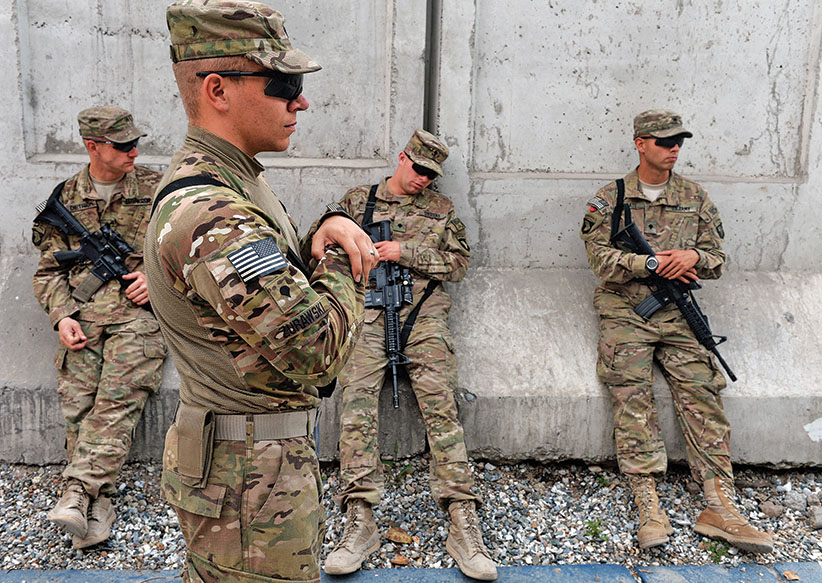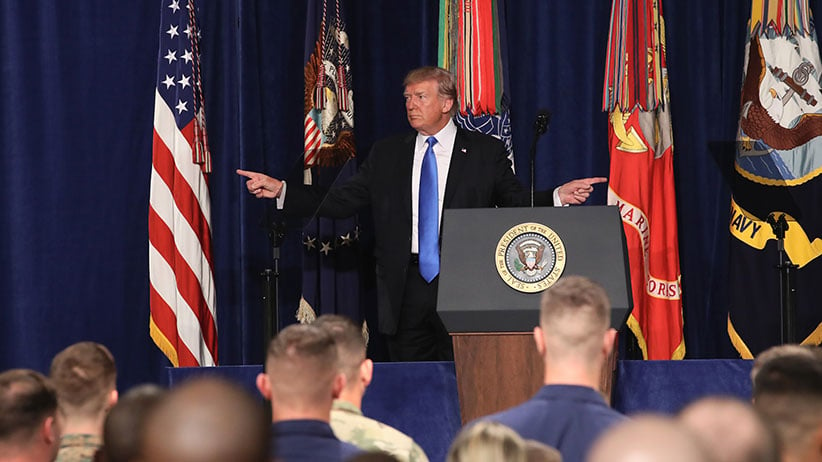Fighting in Afghanistan: ‘You have the watches. We have the time’
The unspoken truth underpinning Donald Trump’s latest policy on Afghanistan is that U.S. troops may never leave. Ever.
US soldiers of the Combined Team Nangarhar of the CT Bastogne, 1st Brigade Combat Team, 101st Airborne Division (Air Assault) of the United States take a break after an award ceremony at Forward Operating Base, Finley Shields in Jalalabad in Nangarhar province on April 6, 2013. An estimated 100,000 foreign troops have been fighting the Taliban for the past 11 years and are due to leave Afghanistan by December 31, 2014 to be replaced by a smaller contingent to train and advise their local counterparts. (Manjunath Kiran/AFP/Getty Images)
Share

Donald Trump has now officially made Afghanistan his war. How ironic. The man who portrays himself as the great isolationist, who threatens to build walls around the U.S. both literally and, in the case of trade, figuratively, is proving to be all bluster and no border. “A hasty withdrawal [from Afghanistan] would create a vacuum that terrorists, including ISIS and Al Qaeda, would instantly fill, just as happened before Sept. 11,” Trump said recently in his heavily promoted Afghan policy speech.
If that political whiplash requires a neck brace, it might be because you recall, say, his January 2013 tweet: “Let’s get out of Afghanistan. Our troops are being killed by the Afghanis we train and we waste billions there. Nonsense! Rebuild the USA.” That’s all changed, apparently. So what does it mean for Canada?
Nothing immediately, at least not in terms of Afghanistan. Justin Trudeau has been clear that Canada will not re-engage militarily in a country where we lost 158 military personnel, but just in case there had been any recent deliberations—in the accelerated world of Trump, every day brings a new change—I asked the Department of Defence late Friday for an update and the answer was still an unequivocal no. “The PM was pretty definitive in his comments in June and again in August about not sending Canadian soldiers back to Afghanistan,” DND spokesperson Jordan Owen wrote. It’s not a surprise Canada is a big no. Trump’s strategy is, at best, ambiguous, and at worst, not a strategy at all.
“We will not talk about numbers of troops or our plans for further military activities,” Trump declared in his policy speech. Fair enough. He may not want to tip off the enemy, but how will the public know how many resources will be committed to the fight, as well as the metric for success? Part of the strategy may be that the public can’t measure failure if it has no idea what success looks like. It gets even more opaque.
“Conditions on the ground, not arbitrary timetables, will guide our strategy from now on,” Trump went on to say. “America’s enemies must never know our plans or believe they can wait us out.” For the military, this is a key strategic shift. Trump has turned one of the great Afghan war vices—a plan for an exit after 16 bloody years—into a military virtue. We won’t leave until the conditions are right. What are those conditions? No one really can say. Still, for all the imprecision, it’s surprising that so many Canadian experts who were deeply involved in the Afghan war—the very people who once promised to get Canada out of the war—believe the Trump assessment is right.
“The key difference with this announcement is that this is a conditions-based approach,” retired Major General David Fraser told me. Fraser was the commander of the Multinational Brigade in Kandahar in 2006. “No time limits. Good!”
To fully appreciate why the time limit issue is so convincing to military vets, it’s useful to go back to Canada’s former Chief of the Defence Staff Rick Hillier, under whom Fraser served. Years ago, during the Afghan war, Hillier told me something that I’ve never forgotten. A Taliban commander had assessed the massive firepower the West had assembled in Afghanistan, and even as he saw his own forces lose battle after battle, he remained unmoved. “You have the watches,” the Taliban commander apparently told Hillier, “but we have the time.” It haunted Hillier. The Taliban were prepared to wait out the West and take the losses. It was prophetic. Canada’s military is long gone from the battle field while the Taliban have reasserted control over large swaths of the country.

Trump’s “condition-based” strategy—technically it is Secretary of Defense, retired General James Mattis’s idea—answers this “watch” question, although there are still logical leaps of faith. How will an increase of troops to a total of about 13,000 troops turn the tide of a war that didn’t end when the 2011 U.S. “surge” had more than 100,000 soldiers in country? Fraser argues it still might work.
“The (additional) resources measuring 4,000—my guess based on sources—will focus on Special Operations Forces, air and aviation, governance and other enabler capacity building,” Fraser said. Training for the Afghan army will also continue. “Once these efforts are self-sustaining that will be one of the conditions to leave for the U.S.” But since that kind of capacity has never been “self-sustaining” before with more forces, why should it be now with less? Fraser is well aware that other conditions will have to be met.
“Other conditions necessary for an exit include demonstrating to the Taliban that the U.S. is not leaving and will sustain this for as long as necessary,” Fraser says.
RELATED: The world must finish its job—and protect its legacy—in Afghanistan
“It will force the Taliban to the table to negotiate a settlement. Similar political pressure will be put on the Afghan authorities, Pakistan and India by the Americans to find a diplomatic solution once ops are more stable.” Amazing that the old Jack Layton solution of making peace with the Taliban, once derided, is now mainstream. And Fraser and others are not wrong to point out that Trump is right to call out Pakistan and its support of terror networks in Afghanistan. That country, according to most U.S. and Canadian experts, has long been the source of the funding and arms for the Taliban. Direct pressure on Pakistan as opposed to mere diplomatic messaging is needed. But Fraser knows all this is years away. “This will not be a short term campaign,” he says of a war that is already the longest in American history.
There is no watch now, only time. This is now a war without end. The U.S. has signalled it will never leave Afghanistan. It doesn’t want to win, but it also doesn’t want to lose. The goal is controlled chaos, containment, neither peace nor war.
It’s not as crazy as it sounds. During the war in Iraq, I spent a little time onboard the USS Harry S. Truman, an aircraft carrier leading the 5th Fleet in the Persian Gulf. As long as the Empire State building and carrying more than 5,000 men and women, the nuclear-powered aircraft carrier was launching F/A-18 jets on bombing missions over Iraq and Afghanistan. The ship was cruising off the coast of Iran and guarding the shipping lanes through the Strait of Hormuz. The commander of the ship was Admiral William Gortney, an extraordinary former fighter pilot. He retired recently after serving as commander of NORAD. On the bridge of the aircraft carrier, I asked the admiral how long the U.S. would remain in this battle, spending billions of dollars on a massive extension of power. Gortney shrugged at the thought and looked out over the sea. He reminded me that the U.S. still has huge military bases in Japan and Germany 70 years after World War II.
He was saying the U.S. is never leaving. Afghanistan is no different. It is the Colin Powell Pottery Barn rule: you break it, you own it.